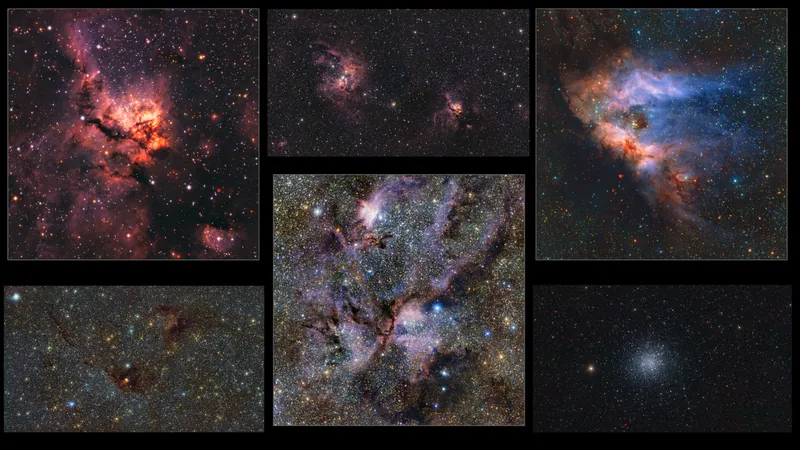
32 Unconventional Methods to Combat Climate Change That Could Actually Work
2024-09-28
In an era where climate change is an ever-growing concern, scientists are brainstorming bizarre and innovative solutions to combat this pressing issue. Strategies to mitigate greenhouse gas emissions, slow glacier melting, and regulate the sun’s rays are being explored. Humanity's future hinges on reducing reliance on fossil fuels and minimizing our depletion of natural resources.
Here are 32 of the most unconventional ideas scientists have proposed to tackle climate change effectively:
1. Artificial Volcanoes
Scientists are considering the creation of artificial volcanoes as a means to combat global warming. This "Pinatubo strategy" involves injecting sulfur compounds into the stratosphere to mimic the cooling effects of natural volcanic eruptions by reflecting sunlight away from Earth.
2. Reflective Blankets for Greenland
An intriguing suggestion includes wrapping Greenland’s glaciers in reflective blankets to decrease melting rates by deflecting sunlight. This concept was put to the test using large, white polypropylene sheets in various studies.
3. Garlic-Fed Livestock
Since livestock contribute significantly to methane emissions, it has been proposed to feed them garlic. Research indicates that garlic’s natural compounds can reduce methane release and offer health benefits for meat and dairy consumers.
4. Mechanical Trees for CO2 Absorption
Innovative “artificial trees” equipped with carbon-capturing technology are being developed. These structures can absorb carbon dioxide 1,000 times faster than natural trees, marking a significant advancement in climate engineering.
5. Fertilizing Ocean Phytoplankton
Scientists are experimenting with iron fertilization of the oceans to stimulate phytoplankton blooms, which absorb CO2. This method highlights the importance of the ocean in climate solutions but remains contentious due to potential ecological impacts.
6. Synthetic Whale Feces
In efforts to enhance oceanic carbon capture, researchers are looking to create artificial whale dung using iron-rich materials to promote phytoplankton bloom, potentially offsetting greenhouse gas emissions by an impressive margin.
7. Snow Cannons for Antarctica
As a solution to halt the collapse of Antarctica's western ice sheet, massive snow cannons that can create artificial blizzards have been proposed, which could stabilize ice loss and possibly lower sea levels.
8. Drone Planting
Using drones to drop "seed bombs" in deforested or hard-to-reach areas could rejuvenate ecosystems after natural disasters, emphasizing the importance of reforestation in mitigating climate change.
9. Lab-Grown Meat Criticisms
While lab-grown meat promises lower emissions, recent studies suggest its production might create more greenhouse gases than traditionally sourced meat. Nevertheless, it still offers animal welfare advantages.
10. Transitioning to a Plant-Based Diet
Shifting to a predominantly plant-based diet has been identified as crucial for significantly reducing global emissions, with studies suggesting that such dietary changes could lower national carbon footprints dramatically.
11. Plastic-Eating Enzymes
Innovative enzymes capable of breaking down plastic waste, such as hydrolase variants, may pave the way for resolving the global plastic crisis and its associated carbon emissions.
12. Cloud-Making Fleets
The concept of marine cloud brightening (MCB) suggests deploying ships to enhance cloud cover, which could cool the atmosphere, highlighting unique engineering possibilities for climate intervention.
13. Underwater Barriers for Glaciers
Researchers are exploring the construction of underwater walls to shield glaciers from warm waters, thus reducing melting and stabilizing sea levels further.
14. Solar Engineering Techniques
Using solar engineering methods to intentionally dim the sunlight reaching Earth may create a cooling effect, helping to maintain temperature targets set by international climate agreements.
15. Spraying Ice with Reflective Beads
Researchers are investigating the use of reflective glass beads to coat Arctic ice, with hopes that this could slow the melting process and prolong the health of existing ice.
16. Utilizing Human Waste in Agriculture
Composting human waste effectively not only provides sustainable fertilizers but also greatly reduces greenhouse gas emissions from poorly managed waste systems.
17. Insect Protein Sources
Insects offer a sustainable protein alternative, emitting significantly lower greenhouse gases than traditional livestock while being nutritiously dense, possibly serving as a solution to food security concerns.
18. Algae for Diverse Solutions
Microalgae can play a multifaceted role in carbon capture, biofuels, and even as nutritious food ingredients, paving the way for a greener economy.
19. Harnessing Human Body Heat
Innovative architectural designs now incorporate harnessing human body heat, which could be utilized to warm buildings, thus addressing urban heating challenges sustainably.
20. Natural Carbon Capture Using Asbestos
Surprisingly, the natural form of asbestos has been studied for its potential to act as a carbon sink, opening pathways to unconventional environmental remediation techniques.
21. Painting Mountains White
Experiments have shown that painting mountains white could reflect sunlight and protect glaciers from melting, representing an unexpected geoengineering tactic.
22. Increasing Arctic Sea Ice
By actively managing seawater ice thickness through controlled freezing, scientists hope to restore and preserve Arctic ice, combating ongoing climate change effects.
23. Trash-Based Construction
Recycling materials for construction presents a compelling option to drastically reduce the carbon footprint of new buildings. Innovations using plastics for bricks could revolutionize the industry.
24. Carbon Sequestration Techniques
The innovative practice of capturing, storing, and eventually burying carbon emissions underground could offer a powerful tool for mitigating climate change impacts.
25. Space-Based Solar Power
Explorations into harnessing solar energy from space through orbital panels suggest that this method could help achieve global net-zero emissions goals.
26. Flight Reduction Initiatives
Flying accounts for a notable portion of global emissions, and encouraging alternatives to air travel may significantly contribute to reducing personal carbon footprints.
27. Algae to Combat Ocean Acidity
Algae's ability to neutralize ocean acidity and enhance carbon capture highlights its potential as a holistic approach to ocean health and climate mitigation.
28. Resurrection of Woolly Mammoths
Pioneering genetic research aims to resurrect woolly mammoths as a means to restore ecosystems in the Arctic, thereby influencing greenhouse gas dynamics favorably.
29. Potty-Training Cows
Innovative projects that aim to train cattle to use designated toilets could reduce harmful emissions resulting from waste, showcasing the intersection of animal husbandry and climate science.
30. High-Altitude Wind Farms
The development of airborne wind energy technology holds promise for tapping into higher-speed winds, generating renewable energy without conventional turbine installations.
31. Engaging People through Nature
The United Nations has underscored actions individuals can undertake to reduce carbon footprints, emphasizing the role of sustainable practices and community engagement in combating climate change.
32. Promoting Green Education and Awareness
Fostering a deeper understanding of ecological imperatives through education can inspire movements toward sustainability and long-term ecological stewardship.
As these imaginative solutions gain traction, they serve as reminders of the innovative approaches necessary to tackle one of humanity's greatest challenges. While some ideas may sound outlandish, they reflect the urgent need for novel strategies to combat the effects of climate change effectively.



 Brasil (PT)
Brasil (PT)
 Canada (EN)
Canada (EN)
 Chile (ES)
Chile (ES)
 España (ES)
España (ES)
 France (FR)
France (FR)
 Hong Kong (EN)
Hong Kong (EN)
 Italia (IT)
Italia (IT)
 日本 (JA)
日本 (JA)
 Magyarország (HU)
Magyarország (HU)
 Norge (NO)
Norge (NO)
 Polska (PL)
Polska (PL)
 Schweiz (DE)
Schweiz (DE)
 Singapore (EN)
Singapore (EN)
 Sverige (SV)
Sverige (SV)
 Suomi (FI)
Suomi (FI)
 Türkiye (TR)
Türkiye (TR)